




|

|
|
|
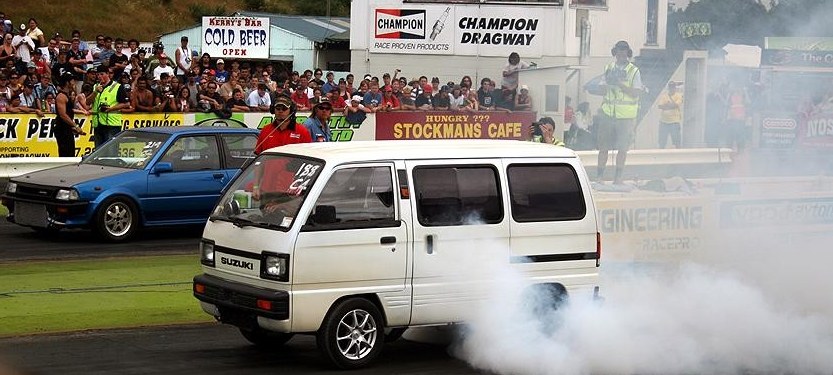
Nitrous Oxide Injection does some strange things to vehicles... NOS... the brand name that became a legend in its own era. So popular in fact that the brand (Nitrous Oxide Systems - NOS for short) is these days used to describe any kind of nitrous kit for any vehicle. Nitrous has become a household word over the last five years and it's popularity with motorheads worldwide continues to increase exponentially with its recent high profile exposure in box office smash movies and the losing of its stigma as an engine killer. Nitrous Oxide automotive kit producers have worked very hard over the last ten years to produce quality kits containing all the necessary parts and instructions for installation by the layman. The quality of the individual kit parts has increased as well and these days modern kits contain enough parts reliability and company knowledgebase to make a nitrous oxide installation a real proposition for the racer on a budget. Dollar for Dollar there is no greater horsepower increase available for the piston engine.
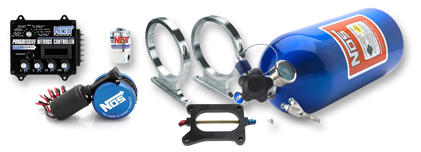
Motorcycle single point injection kit The gas was discovered by Joseph Priestley in 1772 and is most commonly made by fusing and "boiling" ammonium nitrate to form steam, nitrous oxide, nitrogen, ammonium nitrate 'fog' and small amounts of very toxic higher oxides of nitrogen. Nitrous oxide is a chemical compound with the formula N2O. Under room conditions it is a colourless non-flammable gas with a pleasant, slightly-sweet odour. It is used in surgery and dentistry for its anaesthetic and analgesic effects, where it is commonly known as laughing gas due to the euphoric effects of inhaling it. Automotive N2O is different from the medical grade stuff and is definitely NOT good for inhalation due to the added sulphur content. Other uses include being used as an propellant oxidizer for rocket engine designs that use solid fuel with a liquid or gaseous oxidizer. In car racing, nitrous oxide (often just referred to as "nitrous") is injected into the intake manifold (or carburettor spacer) to increase power: even though the gas itself is not flammable, it delivers more oxygen than atmospheric air by breaking down at elevated temperatures, thus allowing the engine to burn more fuel and air. Additionally, since nitrous oxide is stored as a liquid, the state change of liquid nitrous oxide in the intake manifold to a gas causes a large drop in intake charge temperature. This results in a denser charge and can reduce detonation as well as increase power available to the engine. When nitrous oxide is heated to about 300 degrees C, it splits into oxygen and nitrogen (normal combustion temps in a piston engine are 500-850 C). The injection of nitrous oxide into an engine means that more oxygen is available during combustion allowing more fuel to be burnt. The same technique was used during by World War II Luftwaffe aircraft with the GM 1 system to boost the power output of aircraft engines. Originally meant to provide the Luftwaffe standard aircraft with superior high-altitude performance, technological considerations limited its use to extremely high altitudes. Accordingly, it was only used by specialized planes like high-altitude reconnaissance aircraft, high-speed bombers and fighter interceptors like the Messerschmitt 109. The British Spitfire fighters also had a nitrous oxide injection system on their Rolls Royce Merlin engines giving them a 2-3 minute speed burst when needed.

ME-109 The only problem with nitrous oxide is that it is fairly bulky and the engine needs a lot of it. For example, a 5-liter engine running at 5,000 RPM will consume a tremendous amount of air every minute so it would take a huge amount of nitrous oxide to run a car continuously (damn, that would be fun though!). Consequently, a car normally carries only a few minutes worth of nitrous oxide and the driver uses it very selectively by pushing a button, usually keeping bursts to under 15 seconds to keep engine temperatures down. One of the major problems of using nitrous oxide in a piston engine is that it can produce enough extra power to destroy the engine. Power increases of 10-300% are easily possible and unless the motor is strong enough to stand it it will not survive. Off the shelf kits are readily available in all power levels but it is recommended to keep power increases on standard motors to about the 30% range to keep engine longevity intact. Bigger increases will require a performance built engine with things like a bulletproof block, super tough bottom end, forged rods and pistons. An extremely important part of a nitrous oxide system is getting the delivery of nitrous oxide and additional fuel at the correct proportions (called a stoichiometric ratio). If you feed nitrous into the engine without enough extra fuel, the suddenly VERY lean air/nitrous to fuel mixture will create a catastrophic detonation problem. Combustion temperatures will skyrocket and complete engine failure is imminent. If the proportion is such that too much fuel is delivered, the power advantage degrades rapidly with a stoichiometric ratio of 1:11 or greater (1 part fuel to 11 parts air).
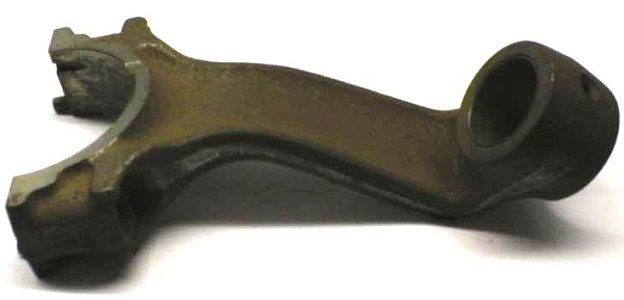
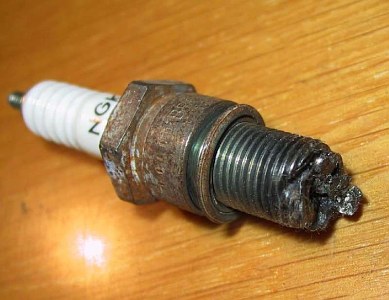 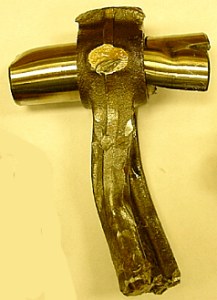
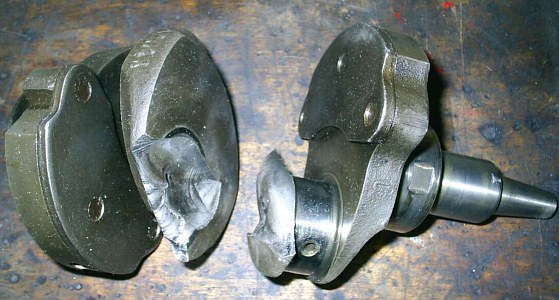
This is the kind of engine damage you'll see when trying to extract way too much power from a standard engine whether you use nitrous, turbo's or blowers. There are several ways of introducing nitrous into a motor and all of them have their place: Dry nitrous system: This system injects nitrous oxide only with no extra fuel delivered by the kit. Useful in low power / short term increases (typically 10-25%) in diesel engines. Can also be used for bigger power increases in petrol engines where the vehicles injection system can deliver increased fuel flow under an active nitrous injection condition. Wet nitrous system: This system injects both nitrous and extra fuel in the correct ratio. Different power levels are easily changed by swapping the screw in jets for larger or smaller ones. All kit manufacturers recommend using a separate fuel pump and fuel line for their kits as the standard ones cannot keep up with the increased flow requirements that a big horsepower kit will need. We all know by now what happens when you lean out a motor at high revs, don't we ......

Nitrous Oxide Injection Kit Single point injection: This kind of kit supplies the nitrous and/or fuel at (you guessed it) a single point. Usually this is the easiest kind of kit to install and is often used on carburetted engine where an additional 10-100% of power is sought. There are a couple of different systems that facilitate single point injection, the most common of which features the injection point in a carburettor spacer that is installed between the carb and the intake manifold. Other systems include inserts that sit inside the air filter assembly and squirt nitrous directly into the carburettor throat. Turbocharged engines also use pre-turbo injection points to avoid injection problems associated with precisely injecting nitrous and fuel into a pressurised environment. A late innovation to turbocharged applications is to drill and tap the turbo housing so the new jets fire directly into the intake impellor at an angle, decreasing spool times when the giggle button is pressed for fast boost. Multi point injection: Used where huge power gains are necessary. This kind of injection setup involves drilling and tapping the intake manifold to inject nitrous and fuel as close to the head's intake ports as possible to maximise power output by equalising each individual cylinder fill while keeping the intake charge at as low a temperature as possible. This kind of kit is alot of work but in a truly awesome turn of events its also the kind of kit you want to use for a custom hidden "stealth" installation whereby no-one even suspects you're using nitrous. All the plumbing is concealed on the underside of the manifold and on a V8 this means the plumbing is concealed inside the engine.
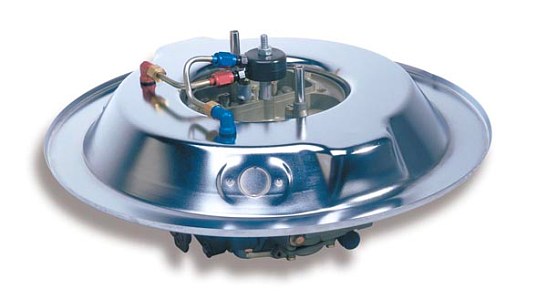
Single Point Injection Hat on a 4 barrel carb 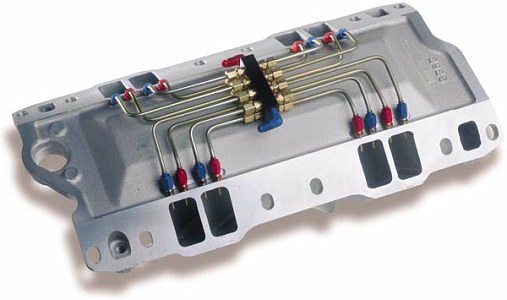
Multi Point Injection Stealth Installation on the underside of a V8 intake manifold Remember that running nitrous in a street car or bike is illegal in most countries, hence the popularity of the stealth setups. There are many, many ways to give a vehicle an insane acceleration but in the dollar to horsepower ratio nitrous injection is by far the cheapest...... and damn good fun to boot!
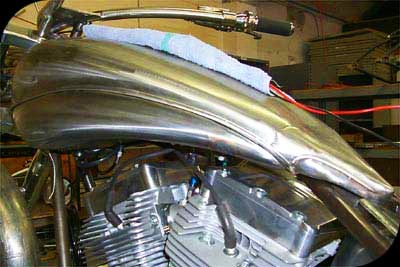 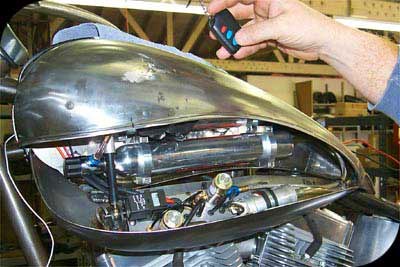
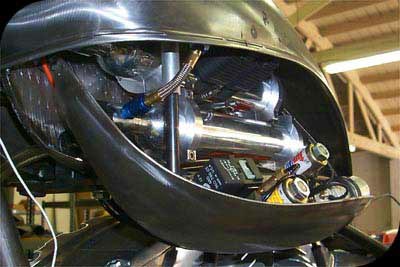
Very clever remote controlled stealth installation inside the fuel tank Going for a 30-50% power increase on a standard motor is a brilliant idea on a motorcycle where that kind of power hike has a significant performance impact due to the bike's light weight compared to a car and doesn't compromise engine longevity much. The torque gains in a V-twin running nitrous are simply amazing and a Harley running this kind of setup is easily able to smash most Jap sportsbikes in a straight line drag.
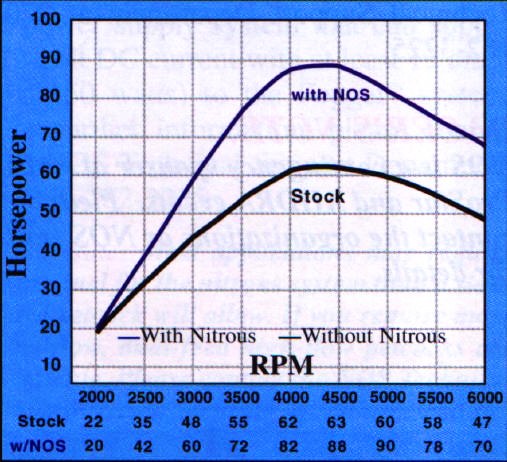
This is a Dyno sheet for a stock 1200cc Sportster after being kitted with Nitrous. What this sheet doesn't show however is the 50+ foot pounds of extra torque the engine made under Nitrous as well as the 30 Horsepower gain..... simply awesome.... 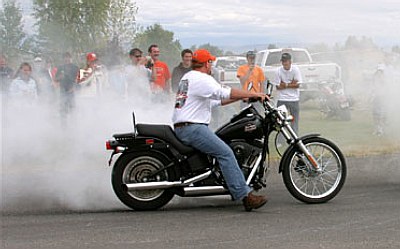
|
Enjoy this article ? The site ? Would you buy me a beer for my efforts?


|

|

|